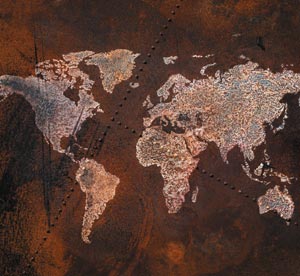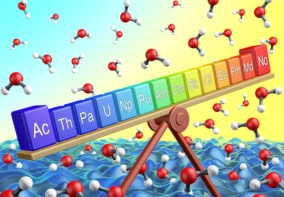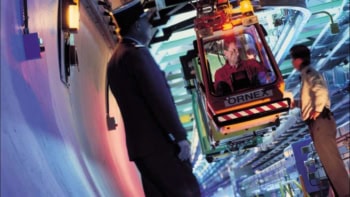
The US possesses just over 10,000 nuclear weapons but plans to reduce this number by about 50% by 2012. The last of America’s 1030 nuclear tests took place on 23 September 1992. The US government has plans to study advanced nuclear-weapon designs, although no such weapons are currently in production. The US has signed, but not ratified, the Comprehensive Nuclear Test Ban Treaty (CTBT). The vast majority of its nuclear weapons are deployed on Trident submarines. The rest are deployed on intercontinental ballistic missiles or long-range B-52 and B-2 bombers.
Russia possesses as many as 16,000 intact nuclear weapons. The former Soviet Union conducted 715 nuclear-weapons tests between 1949 and 1990. Russia maintains a massive nuclear complex, including 10 formerly secret nuclear cities housing hundreds of tonnes of inadequately secured nuclear materials. Russia is dramatically reducing the size of its nuclear arsenal and many older systems are nearing the end of their service lives. It has also signed and ratified the CTBT. Russia continues to develop new nuclear re-entry vehicles – the top part of long-range missiles that deliver nuclear weapons to their targets – and is thought to be pursuing new weapon designs. These new re-entry vehicles are being designed to manoeuvre in the final phases of flight and thwart US efforts to develop effective defences against ballistic missiles.
China has about 400 nuclear weapons and various delivery platforms – mostly short- and medium-range missiles – and is pursuing a slow, but consistent modernization effort. It conducted 45 nuclear-weapons tests between 1964 and 1996. China has signed but not yet ratified the CTBT. It continued to develop more reliable longer-range missiles and is thought to be pursuing systems less vulnerable to destruction by a first strike by another nuclear power. There is no hard evidence that China is working on new types of weapon, but there are no known restrictions to stop its scientists from doing so.
France deploys about 350 nuclear weapons on 84 nuclear-capable aircraft and four nuclear submarines. Three of the subs can carry 16 missiles each. It also has up to 60 aircraft-based nuclear weapons. France conducted 210 nuclear-weapons tests between 1960 and 1996. France produced about 1110 nuclear weapons between 1960 and 1992. It has signed and ratified the CTBT. France is planning to replace its current arsenal of submarine-based ballistic missiles with a more advanced, capable missile-delivery system, but would arm these new missiles with existing nuclear weapons. No new nuclear-weapons development is known to be under way in France.
The UK currently maintains four nuclear-powered ballistic-missile submarines. Each vessel can be armed with up to 16 Trident II missiles and with a total of 48 weapons. Between 1952 and 1992, the country produced approximately 834 nuclear weapons. It has conducted 44 nuclear-weapons tests, the first on 30 October 1952 and the last on 26 November 1991. It has signed and ratified the CTBT. The UK is dependent on US nuclear test facilities and would be unable to test or certify deployment of any new weapons unless the US resumed testing its own weapons.
Israel is thought to possess enough nuclear material for 100-170 nuclear weapons. Israel has not acknowledged that it has nuclear weapons, but is indisputably regarded as a de facto nuclear-weapon state. The exact number of weapons is unknown but is more likely on the lower end of the possible range. In all, Israel may have produced 530-684 kg of weapons-grade plutonium since work at its Dimona research reactor began in 1964. Plutonium separated from the reactor’s fuel rods allowed Israel to build its first nuclear device by late 1966 or 1967, becoming the sixth nation to do so. It can deliver nuclear weapons by aircraft, ballistic missiles, and ship- and submarine-launched cruise missiles. Israeli scientists are probably pursuing advanced designs for nuclear weapons, but details are sketchy.
India has components to deploy a small number of nuclear weapons within a few days or weeks, with fighter-bomber aircraft being the most likely delivery vehicle. India may have enough weapons-grade plutonium to produce 75-110 nuclear weapons, although how many it has produced is unknown. It tested a “peaceful” nuclear device in 1974 and carried out five further “Shakti” [strength] tests in May 1998. Since then, the pace of India’s weapons programme has been moderate. It continues to produce nuclear materials for use in weapons, but has not officially stated how many weapons it has or plans to produce. India is not a member of the Non-Proliferation Treaty (NPT) and has not signed the CTBT. Indian scientists are probably pursuing more advanced weapon designs and could test such weapons quickly if given permission.
Pakistan possesses the components to deploy a small number of nuclear weapons within a few days or weeks. By the end of 2005, Pakistan may have enough weapons-grade uranium to produce 50-110 nuclear weapons. Its nuclear weapons are reportedly stored in component parts, with the fissile core separated from the non-nuclear explosives, although exactly where is not publicly known. Like India, Pakistan has refused to sign the NPT. It has, however, signed but not ratified the CTBT. Pakistani scientists are likely pursuing more advanced designs and could test such weapons quickly if given permission.
North Korea has an active nuclear-weapons programme and may already possess enough separated plutonium to produce as many as nine nuclear weapons. It is unclear how many, if any, weapons North Korea has built. US intelligence agencies have stated that “in the mid-1990s North Korea had produced one possibly two, nuclear weapons”, but this estimate may be based on assumptions about the country’s intentions and capabilities rather than direct evidence. Very little is known about North Korean weapons work, but its weapons are most likely of simple, first-generation designs. North Korea’s ability to develop more advanced designs is unknown, although it is very likely working on such advancements.
• Source: J Cirincione, J B Wolfsthal and M Rajkumar 2005 Deadly Arsenals: Nuclear, Chemical and Biological Threats (Carnegie Endowment for International Peace)



